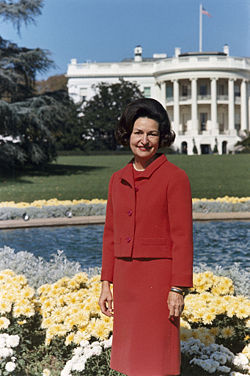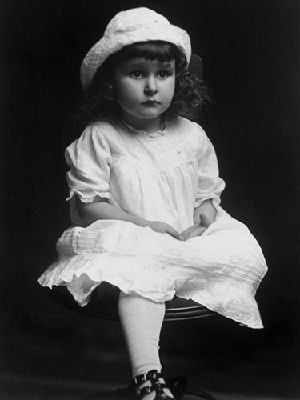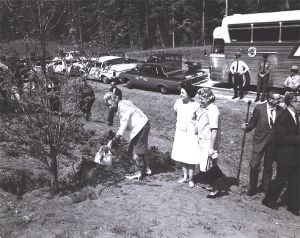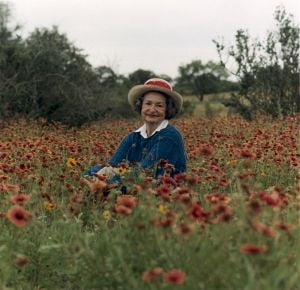Lady Bird Johnson
| Claudia "Lady Bird" Johnson | |
 Lady Bird Johnson at rear of White House
| |
| Born | December 22 1912 (age 112) Karnack, Texas, U.S. |
|---|---|
| Occupation | First Lady of the United States |
| Predecessor | Jacqueline Bouvier Kennedy |
| Successor | Pat Nixon |
| Spouse(s) | Lyndon B. Johnson |
| Children | Lynda and Luci |
| Relatives | Thomas Jefferson Taylor and Minnie Pattillo |
Claudia Alta (Lady Bird) Taylor Johnson (December 22, 1912 ‚Äď July 11, 2007) was the wife of President of the United States Lyndon B. Johnson. Throughout her life, she was an advocate for beautification of the nation's cities and highways and conservation of natural resources. The former First Lady was a recipient of the Presidential Medal of Freedom and the Congressional Gold Medal.
As First Lady, Johnson started a capital beautification project (Society for a More Beautiful National Capital) to improve physical conditions in Washington, D.C., both for residents and tourists. Her efforts inspired similar programs throughout the country. She was also instrumental in promoting the Highway Beautification Act, which sought to beautify the nation's highway system by limiting billboards and by planting roadside areas. She was also an advocate of the Head Start program.
Early life
Claudia Alta Taylor was born in Karnack, Texas, a town in Harrison County, near the state's border with Louisiana. Her birthplace was "The Brick House," a former slave plantation mansion on the outskirts of town, which her father had purchased shortly before her birth. Her parents, both natives of Alabama, were of English and Scottish descent.
Though she was named for her mother's brother Claud,[1] during her infancy, her nursemaid, Alice Tittle,[2] commented, she was as "purty as a ladybird,"[3] and that nickname virtually replaced her given name for the rest of her life. Her father and siblings called her Lady,[4] though her husband called her Bird, which is the name she used on her marriage license. During her teenage years, her schoolmates called her Bird, though mockingly, since she reportedly was not fond of the name.
Her father was Thomas Jefferson Taylor (August 29, 1874 ‚Äď October 22, 1960), a sharecropper's son who became a wealthy businessman and the owner of 15,000 acres of cotton and two general stores. "My father was a very strong character, to put it mildly," his daughter once said. "He lived by his own rules. It was a whole feudal way of life, really."
Her mother was the former Minnie Lee Pattillo (1874‚Äď1918), an opera lover who felt out of place in Karnack and who was often in "poor emotional and physical health." While pregnant, she died after falling down a flight of stairs when her daughter was five and died of complications after miscarrying. In a profile of Lady Bird Johnson, Time magazine described her mother as "a tall, eccentric woman from an old and aristocratic Alabama family, liked to wear long white dresses and heavy veils [‚Ķ and who] scandalized people for miles around by entertaining Negroes in her home, and once even started to write a book about Negro religious practices, called Bio Baptism." Her unreconstructed husband, however, tended to see blacks as "hewers of wood and drawers of water," according to his younger son.
Lady Bird had two elder brothers, Thomas Jefferson Jr. (1901‚Äď1959) and Antonio, a.k.a. Tony (1904‚Äď1986). She also had two stepmothers, one whom her father divorced and Ruth Scroggins (who married Thomas Taylor in 1937).[5]
She was largely raised by her aunt, Effie Pattillo, who moved to Karnack after her sister's death, though Lady Bird visited her Pattillo relatives in Autauga County, Alabama, every summer until she was a young woman. As she explained, "Until I was about 20, summertime always meant Alabama to me. With Aunt Effie we would board the train in Marshall and ride to the part of the world that meant watermelon cuttings, picnics at the creek, and a lot of company every Sunday."[6] According to Lady Bird, her aunt Effie "opened my spirit to beauty, but she neglected to give me any insight into the practical matters a girl should know about, such as how to dress or choose one's friends or learning to dance."
Lady Bird was a shy quiet girl who spent much of her youth alone in the outdoors. "People always look back at it now and assume it was lonely," she once said about her childhood. "To me it definitely was not. [...] I spent a lot of time just walking and fishing and swimming."[7] She developed her lifelong love of the environment as a child growing up in the tall pines and bayous of East Texas and watching the wildflowers bloom each spring.[8]
When it came time to enter high school (her brothers, however, had attended boarding schools in New York),[9] Lady Bird moved away from home to live with another family during weekdays in the town of Jefferson, Texas,[10] there being no high school in the Karnack area. Eventually, she graduated third in her class at the age of 15, from Marshall Senior High School in nearby Marshall. Despite her young age, she drove herself to school in her own car, a distance of 15 miles each way, because, she said, "it was an awful chore for my daddy to delegate some person from his business to take me in and out."[11] During her senior year, when she realized that she had the highest grades in her class, she "purposely allowed her grades to slip" so that she would not have to give the valedictorian or salutatorian speech.
She studied journalism and art at St. Mary's Episcopal School for Girls, a junior college in Dallas, during which time she converted to Episcopalianism. She graduated with honors from the University of Texas with a Bachelor's degree in Arts in 1933 and a degree in Journalism in 1934‚ÄĒa time when women were hard pressed to have a career of their own, let alone a college education. Her goal was to become a reporter.
Marriage and family
Her goal of a career in media was deferred when a friend in Austin introduced her to Lyndon Baines Johnson, a young up-and-coming political hopeful.[12] On their first date, which was breakfast the next morning at the Driskill Hotel and a long drive in the country, Johnson proposed. Lady Bird did not want to rush into marriage, but Lyndon Johnson was persistent and did not want to wait. The couple married on November 17, 1934, at Saint Mark's Episcopal Church in San Antonio, Texas.
Three years later, when Lyndon decided to run for Congress from Austin's 10th district, Lady Bird provided the money to launch his campaign. She took $10,000 of her inheritance from her mother's estate to help start his political career.
After several miscarriages, they had two daughters, Lynda (born in 1944), whose husband Charles S. Robb went on to become governor of Virginia and a U.S. Senator, and Luci (born in 1947), who married, firstly, Pat Nugent and, secondly, Ian Turpin.
First Lady of the United States
Johnson's press secretary from 1963‚Äď1969 was Liz Carpenter, a fellow University of Texas alumna. Carpenter was the first professional newswoman to be press secretary to a First Lady, and she also served as Lady Bird's staff director.
In 1970, A White House Diary, Lady Bird Johnson's intimate, behind-the-scenes account of Lyndon Johnson's presidency from November 22 1963 to January 20 1969, was published. Beginning with the tragic assassination of John F. Kennedy, Mrs. Johnson recorded the momentous events of her times, including the Great Society's War on Poverty, the national civil rights and social protest movements, her own activism on behalf of the environment, and the Vietnam War. Long out of print, the paperback edition of A White House Diary will be available again through the University of Texas Press in Fall 2007.[13]
She was acquainted with a long span of fellow First Ladies, from Eleanor Roosevelt to Laura Bush, and was protected by the United States Secret Service for forty-four years, longer than anyone else in history.[14]
Later life
After former President Johnson died in 1973, Lady Bird Johnson remained in the public eye, honoring her husband and other Presidents.
In the 1970s, she focused her attention on the Austin riverfront area through her involvement in the Town Lake Beautification Project. From 1971 to 1978, Johnson served on the board of regents for the University of Texas System.[15]
On December 22, 1982 (her 70th birthday), she and actress Helen Hayes founded the National Wildflower Research Center, a nonprofit organization devoted to preserving and reintroducing native plants in planned landscapes, located east of Austin, Texas. The Center opened a new facility southwest of Austin on La Crosse Avenue in 1994. It was officially renamed The Lady Bird Johnson Wildflower Center in 1998. On June 20, 2006, The University of Texas at Austin announced plans to incorporate the 279 acre Wildflower Center into the University.[16]
For twenty years, Lady Bird Johnson spent her summers on the island of Martha's Vineyard, renting the home of Charles Guggeinheim for many of those years. She said she had greatly appreciated the island's natural beauty and flowers. On October 13, 2006, Johnson made a rare public appearance at the renovation announcement of the Lyndon Baines Johnson Library and Museum. Sitting in a wheelchair and showing signs of recent health problems, Lady Bird seemed engaged and alert, and clapped along with those present at the ceremony.
Health problems and death
In 1993, Johnson's health began to fail. In August 1993, she suffered a stroke and became legally blind due to macular degeneration. In 1999, she was hospitalized for a fainting spell, and in 2002, she suffered a second, more severe, stroke, which left her unable to speak coherently or walk without assistance. In 2005, she spent a few days in an Austin hospital for treatment of bronchitis. In February 2006, Lady Bird's daughter, Lynda Johnson Robb, told a gathering at the Truman Library in Independence, Missouri, that her mother was now totally blind and was "not in very good health."[17]
In June 2007, Johnson spent six days in Seton Hospital in Austin after suffering from a low-grade fever. At 4:18 p.m. (CDT) on July 11, 2007, she died at home of natural causes, surrounded by members of her family.
Memorial services
Johnson's family held a private mass at the Lady Bird Johnson Wildflower Center on July 13. The public was able to pay tribute as she lay in repose in the Great Hall of the Lyndon Baines Johnson Library and Museum from the afternoon of July 13 to the morning of July 14. The library remained open all night as more than 12,000 mourners filed by her casket.
The funeral services took place at Riverbend Center in Austin on the afternoon of July 14. The service was by invitation only due to limited space at the venue. Those in attendance included First Lady Laura Bush, former Presidents Jimmy Carter and Bill Clinton, and former First Ladies Hillary Rodham Clinton, Barbara Bush, Nancy Reagan, and Rosalynn Carter. Former First Lady Betty Ford was unable to attend the funeral service and was represented by her daughter Susan Ford. In addition, Caroline Kennedy and Tricia Nixon Cox represented their former first families.
At 9 a.m. on July 15, a ceremonial cortège left the Texas State Capitol. The public was invited to line the route through downtown Austin on Congress Avenue and along the shores of Town Lake to pay their respects. The public part of the funeral procession ended in Johnson City. The family had a private burial at the Johnson family cemetery in Stonewall, where Johnson was laid to rest next to her husband.
Legacy
Lady Bird Johnson was awarded the Presidential Medal of Freedom by Gerald Ford on January 10, 1977. The citation for her medal read:
One of America's great First Ladies, she claimed her own place in the hearts and history of the American people. In councils of power or in homes of the poor, she made government human with her unique compassion and her grace, warmth and wisdom. Her leadership transformed the American landscape and preserved its natural beauty as a national treasure.
Johnson then received the Congressional Gold Medal on May 8, 1984.
In addition to the Lady Bird Johnson Wildflower Center, her name has been lent to the Lady Bird Johnson Park on Columbia Island in Washington, D.C., which was founded as a result of her efforts as First Lady to beautify the capital.
Remembrances of Lady Bird Johnson
In the wake of Johnson's death, a number of politicians and dignitaries made public statements in remembrance of the former First Lady:
- Former President Jimmy Carter and First Lady Rosalynn Carter: "Many people's lives are better today because she championed with enthusiasm civil rights and programs for children and the poor."
- Former President George H. W. Bush and First Lady Barbara Bush: "Like all Americans, but especially those of us who call Texas home, we loved Lady Bird … She made the world beautiful in so many ways, and was beautiful to all of us who knew and loved her."
- Former President Bill Clinton and Senator Hillary Rodham Clinton: "Lady Bird was a strong woman who inspired her daughters and other young women to develop and speak their minds."
- President George W. Bush and First Lady Laura Bush: "Mrs. Johnson became First Lady on a fateful day in November 1963 and was a steady, gentle presence for a mourning Nation in the days that followed."
- Former First Lady Betty Ford: "Her beautification programs benefited the entire nation. She translated her love for the land and the environment into a lifetime of achievement."
- Former First Lady Nancy Reagan: "When our nation called upon Lyndon Johnson to take the oath of office in the face of tragedy he did so with his courageous wife beside him. As First Lady she represented our nation with honor and dignity."
- Senator Edward Kennedy: "Lady Bird Johnson was a wonderful first lady and one of the kindest and most caring and compassionate people I've ever met in politics. She was a great friend to the Kennedy family, in both good times and bad, and we cherished every moment we spent with her. May God bless her and her entire family."
| Preceded by: Pat Nixon |
Second Lady of the United States 1961-1963 |
Succeeded by: Muriel Humphrey |
| Preceded by: Jacqueline Kennedy |
First Lady of the United States 1963-1969 |
Succeeded by: Pat Nixon |
| Preceded by: Variable (Ambassadors Extraordinary and Plenipotentiary of foreign nations); next fixed is Condoleezza Rice |
United States order of precedence as of 2007 |
Succeeded by: Betty Ford' |
M. Washington · A. Adams · M. Jefferson Randolph · D. Madison · E. Monroe · L. Adams · E. Donelson · S. Jackson · A. Van Buren · A. Harrison · J. Harrison · L. Tyler · P. Tyler · J. Tyler · S. Polk · M. Taylor · A. Fillmore · J. Pierce · H. Lane · M. Lincoln · E. Johnson · J. Grant · L. Hayes · L. Garfield · M. McElroy · R. Cleveland · F. Cleveland · C. Harrison · M. McKee · F. Cleveland · I. McKinley · Edith Roosevelt · H. Taft · Ellen Wilson · Edith Wilson · F. Harding · G. Coolidge · L. Hoover · Eleanor Roosevelt · B. Truman · M. Eisenhower · J. Kennedy · C. Johnson · P. Nixon · B. Ford · R. Carter · N. Reagan · B. Bush · H. Clinton · L. Bush
Notes
- ‚ÜĎ Palm Beach Post, Vibrant spirit takes Lady Bird from a small town to UT. Retrieved July 19, 2007.
- ‚ÜĎ PBS, Lady Bird Johnson: Her Early Years. Retrieved July 19, 2007.
- ‚ÜĎ Lady Bird Johnson Tribute, Lady Bird Johnson: Final Tribute. Retrieved July 19, 2007.
- ‚ÜĎ Time, The First Lady Bird. Retrieved July 19, 2007.
- ‚ÜĎ University of Texas, The Handbook of Texas Retrieved July 19, 2007.
- ‚ÜĎ Time, So Glad, So Glad. Retrieved July 19, 2007.
- ‚ÜĎ Henry Brandon, "A Talk With the First Lady," The New York Times, September 10, 1967
- ‚ÜĎ Wilson, Janet. "East Texas wildflower." The Austin American-Statesman, July 13, 2007, p.2 (Lady Bird Johnson Commemorative Section).
- ‚ÜĎ Henry Brandon, "A Talk With the First Lady," The New York Times, September 10, 1967.
- ‚ÜĎ Statesman, Former first lady leaves rich legacy as political wife, environmental activist, businesswoman. Retrieved July 19, 2007.
- ‚ÜĎ Henry Brandon, "A Talk With the First Lady," The New York Times, September 10, 1967.
- ‚ÜĎ Axcess News, Lady Bird Johnson, the First Lady a Nation Mourns. Retrieved July 19, 2007.
- ‚ÜĎ University of Texas, A White House Diary, By Lady Bird Johnson. Retrieved July 19, 2007.
- ‚ÜĎ Claudia Feldman, Secret Service agent will miss Lady Bird. Retrieved July 19, 2007.
- ‚ÜĎ Daily Texan Online, A former first lady leaves us her legacy. Retrieved July 19, 2007.
- ‚ÜĎ University of Texas, University of Texas System Regents authorize union of The University of Texas at Austin, Lady Bird Johnson Wildflower Center. Retrieved July 19, 2007.
- ‚ÜĎ Find Articles, Recalling life in the mansion. Retrieved July 19, 2007.
ReferencesISBN links support NWE through referral fees
- Gould, Lewis L. American First Ladies: Their Lives and Their Legacy. New York: Garland Pub. 1996. ISBN 9780815314790
- ‚ÄĒ. Lady Bird Johnson: Our Environmental First Lady. Modern First Ladies. Lawrence: University Press of Kansas, 1999. ISBN 9780700609925
- Russell, Jan Jarboe. Lady Bird: A Biography of Mrs. Johnson. New York: Scribner 1999. ISBN 9780684814803
External links
All links retrieved March 7, 2025.
Credits
New World Encyclopedia writers and editors rewrote and completed the Wikipedia article in accordance with New World Encyclopedia standards. This article abides by terms of the Creative Commons CC-by-sa 3.0 License (CC-by-sa), which may be used and disseminated with proper attribution. Credit is due under the terms of this license that can reference both the New World Encyclopedia contributors and the selfless volunteer contributors of the Wikimedia Foundation. To cite this article click here for a list of acceptable citing formats.The history of earlier contributions by wikipedians is accessible to researchers here:
The history of this article since it was imported to New World Encyclopedia:
Note: Some restrictions may apply to use of individual images which are separately licensed.





